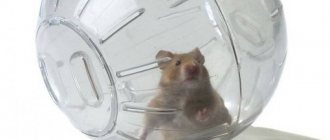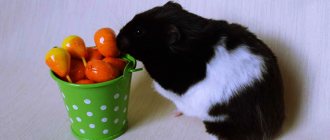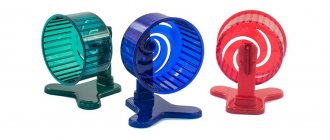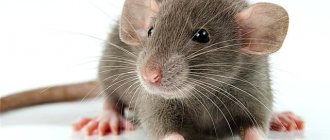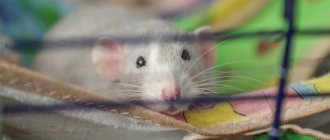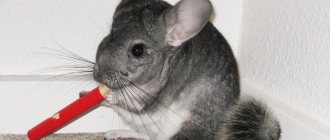- home
- Housing
31.03.2018
Hamsters are very active domestic rodents. Due to their activity, furry animals drink a lot of water, so every caring owner should think about purchasing a good drinking bowl. Stores offer a huge selection of sippy cups, so how to choose a decent option? A water bowl for a hamster is inexpensive, but any investment should be justified. Before purchasing, you should understand what types of drinking bowls there are, find out their advantages and disadvantages, as well as features of use.
Assembly from a plastic bottle
To make a water bowl for a hamster with your own hands, you will need the following materials:
- 05 liter plastic bottle, preferably water bottle;
- self-tapping screw or nail;
- roulette;
- felt-tip pen;
- corrugated tube;
- wire.
To begin with, let's take a plastic bottle and prepare it for use by washing it and cleaning it from any remaining lemonade and labels. Take a self-tapping screw and screw it into the plug. We need a hole slightly smaller in diameter than the size of the tube that we must insert into the cork.
The tube needs to be divided in half, leaving the corrugated part. Insert into the cork so that the height of the tube in the bottle is 2cm, and outside 5cm. To prevent liquid from leaking out when tilting the bottle, the hole made with a self-tapping screw must be smaller than the diameter of the tube. Water flows from the bottle only if the straw is installed incorrectly. To fix the damage, you just need to take another cap and make a new hole in it.
Now we need to use a tape measure and a felt-tip pen to draw a scale on our homemade drinking bowl. Thanks to the markings, you can track the amount of liquid your pet drinks. After the work is finished, you need to attach the bottle with liquid to the cage using wire. We fix the product at a height of 4-5 cm so that the rodent can easily drink water.
So we learned how to make a drinking bowl for a hamster with our own hands. Such a product cannot break: all that needs to be repaired is to change the drinking tube when your pet chews it.
How to install?
Purchasing and making a drinking bowl is not the most difficult task. It is also necessary to properly attach it to the cage so that a playful pet does not spill water and damage the structure. Store-bought copies are usually equipped with special latches, which are very convenient to use in this case.
If the drinker has a hole in the lid for fastening, but there is no latch itself, this is not a problem. It can be made from a small piece of wire, bent along the edges to form peculiar hooks. You can also use thick rope.
You can also secure the drinker using a large plastic cup. To do this, it is turned upside down, and a hole for a drinking bowl is cut out in it. You need to make a small hole on the side into which the tube is inserted. The structure is placed quite stably inside the cage; it can be placed in any free space.
The floor drinking bowl should be equipped with a weighting material, then an active animal will not be able to turn it over. However, you need to take into account that the tank will need to be washed quite often, so you should not secure it thoroughly. It would also be appropriate to place such a structure on a stand. In this case, less dirt will also get into the water, as a result of which it will be possible to change it a little less often.
Drinking bowl
The most affordable option. Its price varies from 15 to 200 rubles, and you can find such an accessory almost everywhere. At the same time, it has the following advantages:
- Ease of use.
- Practicality (easy to clean and can be used for a long time).
- Versatility (placed in any part of the cage).
- Low cost.
However, such a drinking bowl for a hamster is not without some disadvantages. So, hamsters often turn it over, and this can not only lead to the need to constantly clean the cage, but also to the appearance of various diseases in the animals. For example, a rodent can catch a cold from sleeping on a damp bedding or get poisoned by drinking water that has been contaminated with garbage.
Sometimes you can see in pet stores bowls adapted to be attached to a cage. However, even such models are quite easy to knock over, and their contents get dirty just as quickly.
Step-by-step instruction
Now let's look at how to make a drinking bowl for a hamster with your own hands of one type or another.
- Nipple drinkers
Perhaps the best option, which is highly recommended if you want to make it for your pet yourself. You will need a small plastic bottle - half-liter or liter, a body from a regular ballpoint pen, a ball from a bicycle bearing, a weak spring from a fountain pen and a thin stick (even a lollipop will do).
Here's what you'll need to do:
- Place the ball from the bearing into the handle body. Measure the place where it is stuck, and this must be done so that the ball protrudes a little, literally a millimeter, above this mark;
- then remove the ball and saw off part of the body along the mark using a hacksaw;
- put the ball back, then connect the spring with the lollipop stick and also install it inside the prepared body;
- fix the stick on the reverse side so that it, together with the spring, acts as a stop;
- then make a hole in the bottle and insert the manufactured structure;
- Seal the joint thoroughly to prevent water leakage.
You can make a drinking bowl yourself
It is better to use sealant as a waterproofing agent. The glue takes a long time to dry, and besides, it is very toxic, especially for the weak body of a hamster.
- Drinking bowl from a plastic bottle
A very simple and popular solution. This option is perfect for a large and friendly hamster family or for large hamsters that consume a lot of water. Ideally, it is best to take a 0.5 liter bottle.
The process of making such a drinking bowl is extremely simple. You will need to unscrew the cap and make a small hole in the center. It can be drilled or pierced with a hammer and nail, but it is better to heat the nail and melt the hole.
To make a drinking bowl from a plastic bottle, you must follow the instructions
After this, insert a regular cocktail tube into the resulting hole. It is advisable that its diameter be larger than the diameter of the hole - this will help avoid water leakage and the need to solve this problem. If, however, the straw turns out to be smaller than the hole, you will have to seal it using the same sealant or glue.
The straw must be inserted so that the end with the corrugated element is on the outside.
- Drinking bowl from a cut bottle
The manufacturing technology of such a drinking bowl is similar to the method described above.
But there is one important difference - you will first need to cut the plastic bottle into two parts. Its lower part will not be needed in the future.
You can cut the bottle with a stationery knife - this is the best option, and this task is performed very easily. If this tool is not at hand, you can take scissors or a regular kitchen knife, but it is recommended to warm them up first - this will allow you to cut the plastic more evenly and quickly.
The main advantage of a drinker made from a cut bottle over a design made from an uncut bottle is that you don’t need to disassemble anything to replenish water supplies - just top it up. But you need to remember that it is strongly recommended for any breed of hamster to change the water at least once every two days. So in any case, you will have to remove the homemade drinking bowl to change the water.
- Floor drinking bowls
Here you don’t need to have any skills at all, since such a drinking bowl for a hamster can be made very quickly with your own hands. But such designs also have a number of disadvantages. First of all, it is very easy to knock them over; therefore, all the water will fall on the litter, which will have to be taken out and dried for a long time. It should also be noted that the water will quickly become polluted. It will have to be changed at least once a day - and this is not always convenient for the person himself.
This drinking bowl for a hamster is very simple, but not very convenient.
How to avoid this? First, you need to make higher sides so that water does not overflow over them. But the height must be optimal so that the rodent can reach the water without climbing into the drinking bowl. One or two centimeters will be enough. Secondly, attach the container to some heavy object, for example, a wooden block - the hamster will not be able to knock it over.
Materials and tools for making drinking bowls
There is no need to specially purchase materials or tools to construct a drinking bowl. Every home always has what it needs.
Material for drinking bowls:
- container (plastic bottle, medicine bottle, etc.);
- juice straw;
- a metal ball, a fountain pen and a wooden block for the nipple;
- glue "Moment";
- rope or strong thread for hanging.
To make a floor drinking bowl, there is only one requirement - a wooden plank, to which a container should be attached for stability.
Tools for work:
- sharp knife;
- ruler;
- marker;
- hammer;
- nail (or drill).
This kit is enough to make a sippy cup for a hamster.
How to accustom a rodent to a drinking bowl
It is not enough to equip a hamster's cage with a water supply structure. You also need to teach your pet how to use it. There are no problems with those in which the water flows by itself (made from a bottle or a cut bottle with a straw). After all, they use a familiar bowl in which liquid accumulates that the hamster can easily drink.
But what about an automatic drinker equipped with a nipple tube? This issue needs to be studied more closely.
Hamster drinks water from a drinking bowl
Usually there are no problems here. Little hamsters, having seen several times how adults drink from a drinking bowl, quickly understand how to get the desired water. If your pet does not have this skill, just show him the water bowl, press it with your finger, squeezing out a drop of water, and wet the rodent’s nose with it. Then bring the hamster to the sippy cup and gently press its nose onto the nipple, causing the water to flow. After several such exercises (repeat them at intervals of several hours or even days), almost all rodents understand what needs to be done to get drunk.
Varieties
All toys that are chosen for pet rodents are aimed at two tasks:
- search for treats;
- encouragement to move and be active.
In some products, these two purposes can be successfully combined. It is worth noting that the treat for the hamster is safely hidden. To get to a tasty treat, you need to go through a maze or cope with a tricky structure. The smell of food is an additional incentive to go through the maze or perform other actions.
Other products that do not hide food are considered exercise equipment. The most common toy of this type is the running wheel.
How to make your own hammock
You can make a hanging bed for your pet yourself in literally a couple of hours, if you know how to sew, weave or knit at least a little.
From felt boots
The easiest option to make with your own hands is a hammock made from felt boots. It is enough to sew ties, straps, chains or carabiners to the felt boots (they can be cut from a worn-out backpack or old bag) so that the boot after hanging remains in a horizontal position, and the toe “looks” up. If desired, several small pockets can be sewn to the outside of the boot in which the ferret will hide his finds.
From a piece of fabric
Another simple option is a hammock made from a piece of fabric made by yourself. To make it you will need dense, soft and preferably natural fabric, it can be drape, denim, cashmere, thin felt, thick linen, etc.
You can also use fleece or faux fur, it is important that the material does not emit a strong odor, otherwise the animal will not use the hammock
The scrap of fabric for the base of the hammock is folded right sides inward and sewn on three sides (by hand or on a sewing machine). Next, the workpiece is turned inside out and the hole is sutured, tucking the cuts inward.
The blanks for the ties are folded in half lengthwise, right sides inward, and stitched with a 0.5 cm indentation from the cuts along the long side. The blanks are turned inside out, helping yourself with a pencil, short sections are tucked inside and sewn up. The finished ties are firmly sewn to the corners of the hammock base.
Tip: if you don’t want to bother with ties, you can use ready-made straps, chains, carabiners or dense cords such as paracord instead.
Hammock pillow
A hammock-pillow is made in almost the same way as a fabric hammock, only you need to take slightly larger scraps of fabric as a basis (at least a square with a side of 35 cm), and after turning the main part of the hammock inside, put foam rubber, rustling balls, or loosely stuff the workpiece with padding polyester, and only then sew up the fourth side. A hanging bed can be supplemented with a secret pocket by sewing another piece of fabric the size of the base to the pillow. In this case, the pet will be happy to “dive” inside this pocket and hide its “prey” in it.
Hammock tube
It’s easy to make a hammock-pipe with your own hands. Two rectangular pieces of fabric measuring approximately 40x60 cm and a piece of thin foam rubber or dense padding polyester slightly smaller than the fabric pieces are folded into a “sandwich”: the first piece of fabric is face down (on the table), a pad is placed on it, and the second piece of fabric is placed on top with the wrong side to the gasket. The “sandwich” is fastened with pins and stitched around the perimeter, tucking the sections of tissue flaps inside. If desired, quilt the entire surface of the workpiece. Next, the workpiece is rolled into a pipe along the long side, and the edges of the pipe are overlapped. Then sew ties and, if desired, pockets to the sides of the pipe and a piece of faux fur to the bottom from the inside.
Types of drinking bowls for pets
Before making a drinking bowl for your pet, it is important to decide on its type. At the moment there are such options as:
- floor type, placed on the floor and characterized by fairly high sides. Their task is to prevent water from spilling on the floor;
- The automatic type is characterized by complete automation of the process. Such drinking bowls ensure a constant supply of liquid to the pet, and also prevent possible flooding of the cage or floor;
- sealed ones help to comply with sanitary and hygienic standards for keeping the animal. It can ensure the constant availability of high-quality liquid for the rodent;
- the hanging type is attached directly to the cage itself. It can be open, but most often there is an indoor version. This type of container is considered one of the most popular among inexperienced animal owners;
- the vacuum type consists of a container for liquid and a tray made of silicone or plastic. The method of operation is to supply water to the tray from a container;
- The nipple type consists of a tube and a flask filled with purified liquid. Also equipped with a special mechanism. Water flows to the hamster only after he presses the mechanism with his tongue. The only disadvantage that stands out is the need to teach the animal to use a drinking bowl;
- bottle type with liquid reservoir. From it, the liquid flows into the prepared container using a special mechanism. Water becomes contaminated over time; one of the disadvantages is the need for frequent washing.
Today there are many ways to make a home watering bowl for your pet. The choice remains only with the owner, and you can assemble the structures even with children. Such activities will develop their motor skills and bring the family closer together.
In the process of creating a drinking bowl, it is only important to remember that hamsters are a type of animal that does not like the frequent presence of people nearby. Therefore, the drinking bowl should be made in larger sizes for better water storage.
How often to refresh the water
The water in the drinking bowl is changed daily
It doesn’t matter whether the hamster managed to drink all the water or not. Otherwise, you risk exposing your pet to illness.
In summer, water should be changed two or three times a day, in winter and autumn at least once a day. It is important to raise the issue of water regime for newborn babies.
They are not yet able to reach the automatic drinker, so the best option would be a small saucer. The water in it needs to be changed every 3-4 hours. In order for your pet to be healthy and happy, he needs good care. Providing clean, fresh water is one way to take care of your pet. You can buy or you can build a simple drinking bowl yourself.
Sippy cup vs. saucer
First, let's find out the best way to give water to your hamster. Two options immediately come to mind: a saucer and a hanging bottle. Let's compare them.
You can give your hamster water without a drinker from a saucer. This option is suitable only for those families in which there is always someone at home. After all, the nimble animal will quickly litter the water in the saucer with bedding, food, and its own fur. In addition, bowls with water tip over very easily and water spills into the filler. And from wet bedding, a homa can easily get wet, catch a cold, and even die from pneumonia.
What can you say about a hanging water bowl for a hamster?
- This is a closed bottle, it is impossible to throw food and filler into the water.
- Drinking from a special sippy cup is much more convenient.
- If the drinking bowl for hamsters is in good working order, it will not leak, and therefore will not cause a cold for the little fluffy one.
- The water is dosed in small drops, it will last for a long time. You don't have to look in 10 times a day and check if your pet has water.
As you can see, bowls do not have any advantage over sippy cups. In addition, some bottles have very original designs.
If you cannot buy a special sippy cup for your fluffy at the moment, use a bowl. But it must be heavy and cylindrical in shape. The water will have to be changed 5-10 times a day, depending on how neat your hamster is.
Why does a ferret need a hammock?
Beginning ferret breeders are often surprised to learn that their pet needs a hammock, and not an ordinary bed, for a comfortable existence and sweet sleep.
Animals can sleep in boxes, on pillows, in their house, and even crawling into a warm sock or felt boot, but only a hammock allows a ferret to feel completely safe. This is due to the fact that wild relatives of domesticated ferrets always choose secluded dark places to sleep - under a stump, in dense bushes, or dig holes. Soft earth or grass perfectly takes the shape of the animal’s body, and it feels protected both from enemies and from bad weather.
Domestic ferrets living in an apartment do not have the opportunity to dig a hole for themselves, and the presence of a sleeping place, the same as dry leaves or grass, makes the pet happy - he sleeps well, so he plays and “hunts” with great pleasure.
Making a water bowl for a hamster with your own hands
- Clean the plastic bottle thoroughly and remove all stickers from it. Using a ruler and marker, draw a line every centimeter on the bottle. This way you can determine how much your hamster drinks. If you notice that the water in the water bottle is not decreasing or decreasing very slowly, you may need to replace the water bottle. It could also be a sign of health problems in your hamster.
- Cut the straw in half and leave the part with the corrugated bend. Remove the cap from the plastic bottle. Make a hole in the cap using a hammer and nail. Pull out the nail and push the tube through the resulting hole. To prevent liquid from spilling, the hole should be slightly smaller in diameter than the straw.
- Fill the bottle with cold water and screw on the cap. Drink some water through a straw - this will allow the water to flow freely through the straw. Use a rope to tie the hamster's water bowl to the cage. The bottle should be secured so that the straw is about five centimeters from the bottom of the cage, so the hamster can easily reach the straw. The straw should not touch the bottom or any equipment of the hamster's cage, as this may cause water to leak.
Tips and warnings
You should empty, clean, and refill your water bottle at least twice a week.
Instead of a hammer and nail, you can use a drill and a bit to drill a hole in the bottle cap. Or you can heat a nail over a fire and pierce the cap with ease.
If the hamster chews on the straw, access to water may become worse or it may stop flowing altogether. In this case, the do-it-yourself drinking bowl for a hamster must be replaced. In particular, you will need to replace the damaged straw with a new one.
You can make a drinking bowl for a hamster with your own hands using a small plate. To do this, simply pour water into a metal, porcelain or plastic saucer and place it in the cage. The disadvantage of this solution is that the water in the plate will often be covered with debris and will have to be changed frequently. Also, a hamster can easily turn over such a drinking bowl.
An improved version of the previous solution could be a small glass jar with a volume of 50-150 ml, for example, baby food. It is more difficult to turn such a drinker over, and since it is also higher than the saucer, it will be more difficult to fill the water with debris.
All of the above is also suitable for other rodents, for example, guinea pigs or chinchillas.
For a long and healthy life of a hamster, a well-equipped home is very important. In nature, animals themselves instinctively arrange their burrows in the best way for themselves. In captivity, a person must take care of this. The main rule for keeping most pets is access to fresh drinking water. You can either purchase a drinking bowl at any pet store or make it yourself.
Why doesn't the animal drink water?
The reasons why a hamster refuses to drink water from a drinking bowl can be varied. If the animal has recently appeared in the family, its stressful state cannot be ruled out. In this case, there is no need to rush things - let him get comfortable and get used to the new living conditions.
Another factor is the inability to use the drinking bowl. We have already discussed above what to do in this situation.
We must not forget that hamsters are nocturnal animals. This means that the peak of their activity may occur at a time when household members are already sleeping. Accordingly, the animal quite possibly uses the drinking bowl, it just does it when no one is looking.
And finally, you need to take into account that the animal needs fresh water, which is recommended to be changed daily. The hamster will not drink stagnant water. It is also necessary to occasionally check how well the drinking bowl is functioning and whether there are any technical faults.
It should also be noted that newborn animals need, just like adults, to receive fresh water.
In this case, it is best to rinse the saucer several times a day and renew the liquid.
How healthy a pet will grow up depends entirely on its owners.
Therefore, having decided to take such an important step as getting a pet, you need to give it maximum attention and provide competent care. Only in this case will the hamster be active, friendly, develop properly and delight its owners
See below for a video review of drinking bowls for rodents.
Training methods
Rats are clean animals, so they usually independently choose a permanent place to relieve themselves (most often this is a corner of the cage). The owner can only put a special plastic or ceramic container there, which can be bought at a pet store. You can also make a toilet for a rat yourself - just take a small container with sides made of plastic or other washable material. To avoid scaring off the rat with an unfamiliar smell, you should add a little used litter to the new litter box. At first, you need to observe the animal, encouraging each use of the tray for its intended purpose with the help of treats.
Open type tray
Closed tray
It happens that an animal goes to the toilet every time in a new place. Even in this case, it is possible to accustom a rat to a litter tray if you are patient:
- Before installing the toilet, the filler is removed from the cage - you can replace it with cloth or paper).
- The cage space is thoroughly washed and disinfected to remove odor.
- A mixture of new and used litter is poured into the toilet container.
- The animal is released into the cage, immediately directed to the tray - if the rat uses the toilet, give it a treat.
Over the next few days you will have to keep an eye on the animal, put it on a tray and don’t forget to encourage it. Thanks to their intelligence, even adult pet rats remember new rules quite quickly. To make the habituation process easier, you can additionally use special sprays for toilet training.
Filler
An important factor is also the filling of the tray. If training is successful, you can use the same material that serves as the main bedding in the cage - for example, sawdust. You can also use a specially designed one - mineral, cellulose or corn. Such fillers are available in the form of granules, which quickly absorb liquid and eliminate the appearance of a strong odor. Accustoming your rat to the tray and using special litter will make caring for the animal quick and easy.
Source
Why doesn't a hamster drink from a drinking bowl?
If the hamster does not drink from the water bowl, then perhaps he has not yet gotten used to the new place, he is stressed, leave him alone for a few days. If he doesn't know how to drink, then he needs to be taught. The reason for refusing water may be succulent food or the physiological characteristics of the pet. All hamsters are different, they are nocturnal animals, they can drink at night, and you won’t see it. Monitor the water level in the drinking bowl.
So, we looked at the main types of drinking bowls for hamsters, the principle of operation, and ways to make and secure them yourself. We can conclude that homemade devices are a temporary option, they are inferior in reliability and can leak, so it is better to purchase a ready-made one. The best option is a nipple drinker; you can choose one on an original stand or a compact hanging one.
What should be in a Syrian hamster's cage?
Syrian hamsters are twice the size of Djungarian hamsters. They lead a more sedate lifestyle and do not run long distance races. They make contact with people much better and are not afraid of them. This is why experts recommend purchasing small cages for Syrians, but be sure to equip them with a running wheel. Dimensions of 30x30 cm or 40x40 cm will be the best option for them.
When setting up a cage, you should give preference to a house of a size where all entrances and exits, as well as windows, will be wide enough so that the hamster can easily cross them.
Syrian hamster cage
When choosing sports equipment for a Syrian, you should make sure that the running wheel is the right size for him. The fact is that these fluffies grow larger than their fellow tribesmen, so a standard wheel may not suit them. The preferred wheel diameter for this breed is at least 20 cm.
How to make a reliable water bowl for a hamster with your own hands?
Step-by-step manufacturing instructions:
- Clear the prepared bottle of stickers: the hamster can peel them off on its own and eat them.
- Make a hole in the lid by driving a nail into it. Make sure its diameter is slightly smaller than the cocktail straw.
- Cut off almost the entire straight part from the tube and insert it into the resulting hole. It should fit snugly. If there are any gaps left, you can cover them with sealant or glue and wait for them to dry.
- Next, you will need to fill the container with water, screw on the lid and attach the drinker to the cage using wire or rope. The location should be such that the tip of the tube is in the air at a height that is comfortable for the animal.
- You can mark the outside of the water bowl with a marker so you can see the amount of water your hamster drinks daily. If it is minor, the animal is probably sick.
An automatic drinking bowl made in this way is distinguished by its ease of manufacture, low cost and convenience for the cage occupant.
It is suitable not only for a hamster, but also for rats, chinchillas, guinea pigs and other small rodents.
Another option for making a drinking bowl for a hamster with your own hands would be a container, the hole of which is covered by a ball. Tools and consumables for the job will be similar to the previous design, but you need to add a metal ball from a bearing or a heavy bead and use a transparent writing pen body instead of a cocktail straw.
- When making a hole in the cap, position the body of the handle at an angle, but it is more rational to cut it directly into the body of the bottle. Heat the nail on the fire and burn a hole of the required diameter.
- The ball from the bearing will become the locking element. Place it in the pen body and mark where it will get stuck, then carefully trim off the excess.
- If necessary, use a pen spring to prevent leaks. It needs to be wedged from the inside with a small piece of wood or plastic, the size of which does not impede the passage of water.
By making such a drinking bowl for a hamster with your own hands, you will save some money on the purchase and will be able to give free rein to your imagination by adding decorative elements for decoration. If you like to frequently feed your hamster treats and treats, then the floor-mounted version of the tank will be the most convenient and rational solution.
- Use a wooden block as a platform to place a container of water. This will raise the level of the drinking bowl above the floor and reduce the degree of contamination of the liquid with debris from the cage.
- Take wide plastic caps and select a bottle of such a diameter that it fits snugly into them. It is advisable to find a container made of thick plastic so that the hamster does not cut himself on the edges.
- Using a utility knife, cut off the top part, leaving the bottom at such a height that it is comfortable for the animal to drink.
- Screw the plastic covers to the block with screws. They will become cup holders.
Such a design will become not only a drinking bowl, but also a homemade feeder for a hamster.
Several lids allow you to expand the number of tanks: pour water into one, pour food into another, and use the third for vegetables and fruits needed for pets.
Don't be afraid to set up your rodent's cage yourself
As you can see, making a drinking bowl is not difficult; you don’t need any special tools or skills to do the job. Don't stop there - create other items the animal needs. For example, you can make a wide variety of toys for your hamster with your own hands: hanging bridges made of wood, dolls made of fabric, halves of walnut shells strung on a rope to grind down the claws and maintain a healthy lifestyle.
Don’t be afraid to show your own imagination and get creative, creating things that will decorate your hamster’s life and allow you to take care of the animal.
How to teach a hamster to drink on its own
If you choose a rodent not from a pet store, but pick it up from friends or acquaintances, it may be too small. The baby will require special care, because the animal can die of thirst. In this case, the responsibility falls on your shoulders to teach him to drink. It is permissible to feed tiny fluffies from a pipette or syringe without a needle, but this option should not take root for long. It is best to train your furry animal to drink on its own, so you can avoid unnecessary problems.
It is not difficult to teach a hamster to drink from a sippy cup, even if he sees it for the first time.
- The animal needs to explore the bottle on its own. Let him examine it carefully.
- Touch the bowl ball with your finger and lubricate the rodent's nose with a drop of water.
- Now touch his nose to the ball.
- These steps must be repeated until the furry animal begins to drink on its own.
From now on, you know exactly what you need to pay attention to when buying a drinking bowl, and you will definitely be able to teach your hamster to drink from it. Good luck finding the best sippy cup for your pet!
Getting your pet used to the sippy cup
Not every rodent will immediately be able to drink water from a new drinking bowl. Usually kids watch how the mother hamster does this, and then repeat after her. Even if your pet has not used a drip sippy cup from an early age, this is not a problem - he can be taught. Initially, it is recommended to place your finger in the water and then let the animal lick it off.
You can independently push your pet to the water access point so that he becomes familiar with the principle of operation of the drinking bowl and tries to drink from it. Repeat this several times and the hamster will start drinking on its own.
The most practical is a nipple drinker, because it is always clean and supplies water as needed.
Often, rodents quickly get used to a new container with drinking liquid, but in some cases there are difficulties.
You need to think about why the animal refuses to drink water. The reasons for this may be the following:
- the animal fails to cope with the task of detecting water;
- the water is dirty;
- The pet extracts the necessary moisture from the food.
When you first bring your hamster to his new home, you should give him time to adapt to his new place. He must explore the space. When the environment is calm, the hamster will naturally find water. If the animal finds it difficult to use the device and you have developed trust with it, you can take the pet and carefully bring it to the water.
The hamsters' native desert is not rich in water. The period of evolution has adapted animals to obtain moisture from the food they eat. If your pet takes a small amount of liquid, do not be alarmed - it is not scary. But it is a mistake to believe that his body is capable of refusing water altogether.
The main task of the drinking bowl is to provide the rodent with fresh drinking water, and its aesthetic design is not so important. You need to constantly monitor the cleanliness of the water, because this is the key to the health of your pet.
Take the choice of a high-quality drinking bowl responsibly - this is extremely important for maintaining the normal condition of the animal.
Types of drinking bowls
There are many types of drinking bowls for small pets, in particular rodents. You can make almost all of them yourself. To do this, you will need a limited set of materials and tools, as well as basic carpentry and repair skills.
Drinkers come in a variety of types, to suit every color and taste.
Homemade drinking bowls differ from each other in design, volume, installation method and other important parameters. Some of them may be temporary, others are established for a long period. Classic options for providing a fun hamster with accessible water supplies are:
Attaching the drinker to the included element
High-quality drinking devices for small animals are in most cases sold with ready-made retainers. With their help, you can secure the drinking bowl securely and safely.
Clamps come in the form of:
- small smooth hooks on the body;
- one large wide hook;
- a plastic rim around a container with a clothespin or pinwheel;
- metal spring;
- silicone suction cup for containers with smooth walls.
The choice of drinking bowl depends not only on its type, but also on the form of attachment, because In different cages, the distance between the rods and their thickness differ, and there may be horizontal rods.
Types of drinking bowls
Depending on their location, they can be external or internal. External ones are fixed outside the cage and do not take up useful space. Water enters the cage through a special spout. The internal spouts are attached directly to the cage.
By design there are:
- Nipple drinkers;
- Vacuum drinkers;
- Floor drinking bowls;
- Bottle;
- Ball drinkers;
Nipple drinkers are based on a spring water supply mechanism. Thanks to this, water does not leak. Vacuum drinkers consist of a tray with a fairly high side and a narrow vessel or flask with water fixed on top. As the water in the pan decreases, water automatically flows from the flask. Vacuum drinkers can also be classified as floor drinkers, but most often these are ordinary open drinkers with a high side.
Bottle drinkers are commonly used for birds. They consist of a reservoir of water and a pocket where water accumulates. The ball drinker is very convenient and practical to use. Water is supplied to the pet if he presses the tongue on the ball at the end of a fixed hard tube. The most common homemade drinkers are:
- Nipple.
- Floor-standing.
- Drinking bottle.
Return to content
What are they?
Drinkers that are used for hamsters at home can be internal or external. They differ in the method of attachment, that is, they can be located inside or outside the cage. In the second case, it turns out to save space inside the pet’s habitat, this is especially true when the home is not too large.
There are many factors to consider when selecting. This is primarily size, convenience, reliability, and method of fastening.
You should also pay attention to stability, safety for the pet, as well as the aesthetic appearance of the structure.
You can also classify devices by design type. They can be suspended or floor-mounted.
As for floor options, they are placed inside the cage. The bowl should have enough weight so that a mobile pet cannot turn it over.
However, it is necessary to take into account the following: since water is in the public domain, it becomes contaminated quite quickly, and it is still possible to accidentally knock it over.
Hanging structures can be secured inside or outside the cage. The container can be open, but closed options are still the most popular. There are vacuum designs that include a container standing on a wide tray with high sides, from which water flows. Not everyone likes this option, since the liquid gets dirty quite quickly and you need to wash the entire device to clean it. Since such drinkers are most often made of soft materials (like plastic), hamsters often chew them.
Nipple drinkers for pets include a flask from which water flows through a tube ending with a locking mechanism. The hamster gets liquid by pressing its tongue on the latch, and the animal will have to get used to this. There are also ball mechanisms that operate in a similar way to the previous one.
Such options are used especially often, because the water remains clean and does not spill throughout the cage.
Some owners choose bottle drinkers with a reservoir. Water slowly flows out of the container into a small depression. These drinkers are most often used by bird owners, but hamsters can also use them. However, with this choice, you need to take into account that the water will also be open and the structure will have to be washed and cleaned frequently.
How to make toys for hamsters with your own hands
Let's look at how to quickly and easily make various toys for hamsters with your own hands from scrap materials.
Ladder (bridge)
Materials and tools:
- cardboard toilet paper rolls;
- wire;
- pencil or pen;
- scissors;
- awl.
Step-by-step instruction:
- Cut the toilet paper roll lengthwise into two equal parts. Repeat the same with all bushings.
- Carefully roll each piece into a tube, wrapping it around a pencil or pen.
- Take out the pencil and roll the resulting tube several times in your palms so that it retains its shape.
- On each part, mark the place where the wire is attached - 1.5–2 cm from the edges of the tube and make through holes in them. In this case, the free edge (cut) of the part should be on the back side of the bridge.
- Make additional holes in the first and last tube so that you can secure the wire and protect your pets from sharp ends.
- Measure the required piece of wire based on the total length of the ladder and a small margin.
- Bend the end of the wire into a hook and thread it into the tube through the back hole. In this case, the tip of the wire should “hide” in the second upper hole.
- String the remaining tube parts onto the wire. Fasten the end of the wire to the last part.
- The ladder is ready. To turn it into a bridge, you just need to bend it in a semicircle.
Video: DIY hamster bridge
Tunnels for hamsters from a plastic bottle
Materials and tools:
plastic bottles; sharp scissors or stationery knife; electrical tape or tape.
Step-by-step instruction:
- Wash all bottles thoroughly and remove labels.
- Trim the top and bottom of the bottles, giving them a cylindrical shape.
- Treat all sections with electrical tape or tape to prevent the hamsters from getting hurt.
- Connect the bottles into a single tunnel using tape. The simplest tunnel is ready. Do not make it too long to maintain good air circulation.
- To complicate the design, you can make a hole on the side surface of one of the bottles, where you can insert the second bottle and secure everything with electrical tape. There may be several such branches.
Swing
Materials and tools:
- children's counting sticks;
- sushi sticks;
- beads with small beads;
- Super glue.
Step-by-step instruction:
- For the swing seat, several counting sticks (about 10 pieces) should be placed end-to-end on the table. In this case, the two outermost ones should be at such a distance from the neighboring ones that beads can be passed through the resulting gap.
- Glue two sticks across the laid out sticks along the edges of the seat, also leaving a small gap between them for the beads.
- Glue two sushi sticks with their thick ends at an angle of about 45 degrees. Do the same with the second pair of sticks. These will be the swing stands.
- Glue the crossbar - another sushi stick - on top between the two posts. For greater stability, additionally secure the structure with rubber bands.
- Pass the beads through the gaps on both sides of the seat and secure them to the crossbar. The swing is ready!
Video: DIY hamster swing
Hammock
Materials and tools:
- felt fabric;
- satin ribbon;
- floss threads;
- scissors;
- chalk or thin soap,
- glue.
Step-by-step instruction:
- Cut two strips of felt measuring 20x24 cm. It is more convenient to cut out both parts at once, fastening them together with pins.
- Using chalk or soap, mark shallow semicircles on the four edges of the felt parts. However, they should not reach the perpendicular edges of the fabric by 1.5–2 cm.
- Trim the fabric on all sides along the intended semicircles.
- Cut a satin ribbon about 22–25 cm long into four parts, singe the ends over the fire so that they do not fall apart.
- Fold a piece of ribbon in half and glue or sew the ends between two corners of the fabric. In this case, the ends of the tape should extend 3–3.5 cm inside the product. Repeat the same for the other three corners.
- Finish all the edges of the hammock with floss threads using a looped (over) stitch in increments of about 5 mm. The hammock is ready!
If desired, you can lay padding polyester or cotton wool between the two parts of the hammock.
Video: how to make a hammock for rats with your own hands
Making simple tunnels
A hamster cage must contain at least one small tunnel. And for games outside the home, complex structures of medium and large size are suitable. You can make a permanent entertainment room for your furry friend or build the attraction anew each time, changing its size and direction of moves.
Children are showing great interest in creating entertainment for hamsters. We invite you to study the instructions for creating simple tunnels that even a schoolchild will understand.
Paper tube for cage
The simplest option is to use a cardboard paper towel tube as a building material. You can put it in the cage unchanged or make windows in the tube so that the animal can come out through them.
The sleeve tube can also be installed in external cardboard labyrinths.
Game room
Do your kids love to play with and watch hamsters? Then give them an idea: make a tunnel for a hamster from an unnecessary cardboard box. The kids will happily get down to business, use their creative imagination and create an attraction with love.
There are a lot of construction options. We will tell you how to make a hamster maze in two different ways.
- The first method does not involve the use of glue. Take a box and pieces of cardboard: 3 strips should correspond in size to the length of the room, 5 to the width. On long pieces, make 5 cuts at equal distances from each other, and cut short pieces three times. Between the cuts, cut out doors, windows and holes for pipes. Now we can assemble our room. Install long partitions with the cuts up, and insert short parts into them with the cut down. You will get a lattice. If you have pipes planned, insert them into the round cutouts. Place the grid in the box and you can start playing right away!
- The second method is based on gluing the walls. It is good because you can create a variety of branches, as well as a rest room for a small creature. To glue the walls, use regular or construction tape.
Labyrinth from a construction set
Preschoolers and schoolchildren love to build various castles and fortresses from construction sets. Invite them to make an attraction for a hamster - they will happily complete this task. Moreover, children themselves know how to make a labyrinth for a hamster from Lego constructors interesting and convenient.
If you are building a walker for a dzhungarik, small parts are better suited. For the larger Syrian breed, use medium sized pieces. Using a small construction set inside the maze, you can build a small obstacle course for the animal, at the end of which you can place a tasty nut.
Book fortress
Old hardcover books are suitable for creating a large, spacious tunnel. To do this, they need to be placed with their roots facing up. It is better to completely enclose the space with books so that the hamsters do not run away in different directions. For one animal, the width of the passage can be 5-8 cm (so that the animal can easily turn around in it), but if you have several fluffies, the tunnels should be more spacious.
In such a book fortress, kids really love to have hamster races. Rodents are placed in a common closed room, after which they open the “door” and watch which of the animals gets to the exit first
At the same time, it is important to ensure that race participants do not violate the rules. If a cunning hamster climbs over the wall, he must be brought back
A maze made from books can also be used to train animals. To do this, you need to place small pieces of tasty food along the chosen path, and repeat the operation several times with the same route. Then you should place the treat only at the exit. You will be surprised how quickly your smart hamster will find it!
Tunnel made of plumbing parts
If your apartment has recently been renovated and you still have unnecessary parts for connecting pipes, use them to create a branched labyrinth! This attraction is suitable for both small Djungarian and larger Syrian and Caucasian hamsters. By the way, the tunnel made from plumbing looks very original. Another advantage is the collapsible design of the attraction, which means you can periodically change the direction of the moves.
Making it is very simple: connect the parts in any direction. It will be more interesting for the hamster to play if there are several exits in the pipe. But in this case, do not leave the home unattended, otherwise you will have to look for it throughout the apartment!
